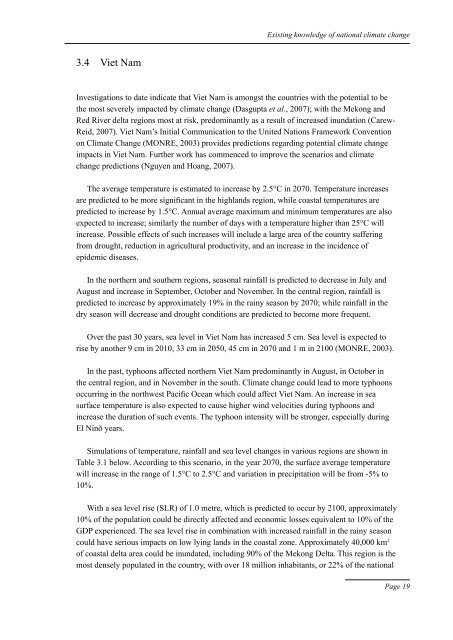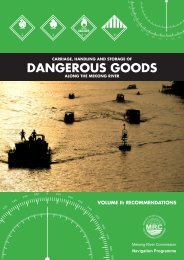Adaptation to climate change in the countries of - Mekong River ...
Adaptation to climate change in the countries of - Mekong River ...
Adaptation to climate change in the countries of - Mekong River ...
Create successful ePaper yourself
Turn your PDF publications into a flip-book with our unique Google optimized e-Paper software.
3.4 Viet Nam<br />
Exist<strong>in</strong>g knowledge <strong>of</strong> national <strong>climate</strong> <strong>change</strong><br />
Investigations <strong>to</strong> date <strong>in</strong>dicate that Viet Nam is amongst <strong>the</strong> <strong>countries</strong> with <strong>the</strong> potential <strong>to</strong> be<br />
<strong>the</strong> most severely impacted by <strong>climate</strong> <strong>change</strong> (Dasgupta et al., 2007); with <strong>the</strong> <strong>Mekong</strong> and<br />
Red <strong>River</strong> delta regions most at risk, predom<strong>in</strong>antly as a result <strong>of</strong> <strong>in</strong>creased <strong>in</strong>undation (Carew-<br />
Reid, 2007). Viet Nam’s Initial Communication <strong>to</strong> <strong>the</strong> United Nations Framework Convention<br />
on Climate Change (MONRE, 2003) provides predictions regard<strong>in</strong>g potential <strong>climate</strong> <strong>change</strong><br />
impacts <strong>in</strong> Viet Nam. Fur<strong>the</strong>r work has commenced <strong>to</strong> improve <strong>the</strong> scenarios and <strong>climate</strong><br />
<strong>change</strong> predictions (Nguyen and Hoang, 2007).<br />
The average temperature is estimated <strong>to</strong> <strong>in</strong>crease by 2.5°C <strong>in</strong> 2070. Temperature <strong>in</strong>creases<br />
are predicted <strong>to</strong> be more significant <strong>in</strong> <strong>the</strong> highlands region, while coastal temperatures are<br />
predicted <strong>to</strong> <strong>in</strong>crease by 1.5°C. Annual average maximum and m<strong>in</strong>imum temperatures are also<br />
expected <strong>to</strong> <strong>in</strong>crease; similarly <strong>the</strong> number <strong>of</strong> days with a temperature higher than 25°C will<br />
<strong>in</strong>crease. Possible effects <strong>of</strong> such <strong>in</strong>creases will <strong>in</strong>clude a large area <strong>of</strong> <strong>the</strong> country suffer<strong>in</strong>g<br />
from drought, reduction <strong>in</strong> agricultural productivity, and an <strong>in</strong>crease <strong>in</strong> <strong>the</strong> <strong>in</strong>cidence <strong>of</strong><br />
epidemic diseases.<br />
In <strong>the</strong> nor<strong>the</strong>rn and sou<strong>the</strong>rn regions, seasonal ra<strong>in</strong>fall is predicted <strong>to</strong> decrease <strong>in</strong> July and<br />
August and <strong>in</strong>crease <strong>in</strong> September, Oc<strong>to</strong>ber and November. In <strong>the</strong> central region, ra<strong>in</strong>fall is<br />
predicted <strong>to</strong> <strong>in</strong>crease by approximately 19% <strong>in</strong> <strong>the</strong> ra<strong>in</strong>y season by 2070; while ra<strong>in</strong>fall <strong>in</strong> <strong>the</strong><br />
dry season will decrease and drought conditions are predicted <strong>to</strong> become more frequent.<br />
Over <strong>the</strong> past 30 years, sea level <strong>in</strong> Viet Nam has <strong>in</strong>creased 5 cm. Sea level is expected <strong>to</strong><br />
rise by ano<strong>the</strong>r 9 cm <strong>in</strong> 2010, 33 cm <strong>in</strong> 2050, 45 cm <strong>in</strong> 2070 and 1 m <strong>in</strong> 2100 (MONRE, 2003).<br />
In <strong>the</strong> past, typhoons affected nor<strong>the</strong>rn Viet Nam predom<strong>in</strong>antly <strong>in</strong> August, <strong>in</strong> Oc<strong>to</strong>ber <strong>in</strong><br />
<strong>the</strong> central region, and <strong>in</strong> November <strong>in</strong> <strong>the</strong> south. Climate <strong>change</strong> could lead <strong>to</strong> more typhoons<br />
occurr<strong>in</strong>g <strong>in</strong> <strong>the</strong> northwest Pacific Ocean which could affect Viet Nam. An <strong>in</strong>crease <strong>in</strong> sea<br />
surface temperature is also expected <strong>to</strong> cause higher w<strong>in</strong>d velocities dur<strong>in</strong>g typhoons and<br />
<strong>in</strong>crease <strong>the</strong> duration <strong>of</strong> such events. The typhoon <strong>in</strong>tensity will be stronger, especially dur<strong>in</strong>g<br />
El N<strong>in</strong>õ years.<br />
Simulations <strong>of</strong> temperature, ra<strong>in</strong>fall and sea level <strong>change</strong>s <strong>in</strong> various regions are shown <strong>in</strong><br />
Table 3.1 below. Accord<strong>in</strong>g <strong>to</strong> this scenario, <strong>in</strong> <strong>the</strong> year 2070, <strong>the</strong> surface average temperature<br />
will <strong>in</strong>crease <strong>in</strong> <strong>the</strong> range <strong>of</strong> 1.5°C <strong>to</strong> 2.5°C and variation <strong>in</strong> precipitation will be from -5% <strong>to</strong><br />
10%.<br />
With a sea level rise (SLR) <strong>of</strong> 1.0 metre, which is predicted <strong>to</strong> occur by 2100, approximately<br />
10% <strong>of</strong> <strong>the</strong> population could be directly affected and economic losses equivalent <strong>to</strong> 10% <strong>of</strong> <strong>the</strong><br />
GDP experienced. The sea level rise <strong>in</strong> comb<strong>in</strong>ation with <strong>in</strong>creased ra<strong>in</strong>fall <strong>in</strong> <strong>the</strong> ra<strong>in</strong>y season<br />
could have serious impacts on low ly<strong>in</strong>g lands <strong>in</strong> <strong>the</strong> coastal zone. Approximately 40,000 km 2<br />
<strong>of</strong> coastal delta area could be <strong>in</strong>undated, <strong>in</strong>clud<strong>in</strong>g 90% <strong>of</strong> <strong>the</strong> <strong>Mekong</strong> Delta. This region is <strong>the</strong><br />
most densely populated <strong>in</strong> <strong>the</strong> country, with over 18 million <strong>in</strong>habitants, or 22% <strong>of</strong> <strong>the</strong> national<br />
Page 19













